Wales have been drawn into Group B for the 2022 World Cup in Qatar. Making up Group B are Iran, USA and England. All sides rank in the top 20 of the FIFA world rankings, making it, based on rankings, the most difficult group.
Having qualified for their second-ever World Cup, Wales will be determined to leave their mark on the upcoming tournament. Previously, Wales qualified for the 1958 World Cup, where they lost 1-0 in the quarter-finals to eventual winners Brazil.
The Wales squad contains several talented and experienced players such as Aaron Ramsey, Joe Allen, Ben Davies and all-time top scorer, Gareth Bale. These four players, along with goalkeeper Wayne Hennessey, are integral to Wales’ success and have been for the last decade. Bale, a former Real Madrid superstar, now playing in the MLS, and Ramsey, previously of Arsenal, now in Ligue 1, both still possess world-class quality. The fitness and availability of these players will be key.
Wales qualified through the playoff route where they successfully beat Ukraine 1-0 after overcoming Austria 2-1 earlier in the year. Their route to the World Cup was no walk in the park, as they showed their grit to secure narrow wins throughout their campaign. Not only this, they were able to earn a draw versus the world number two ranked side Belgium in November 2021.
Head coach Rob Page has recently been given the job permanently after taking over from Ryan Giggs. Page has been a massive success with this squad and although his side suffered two defeats in the final international break before the tournament, there is still great hope and excitement throughout the country.
This tactical analysis will cover the tactics that Page has implemented into his Wales side ahead of the World Cup. This analysis will cover how Wales set up in possession, and out of possession and a little bit of information about the squad,
Predicted starting XI
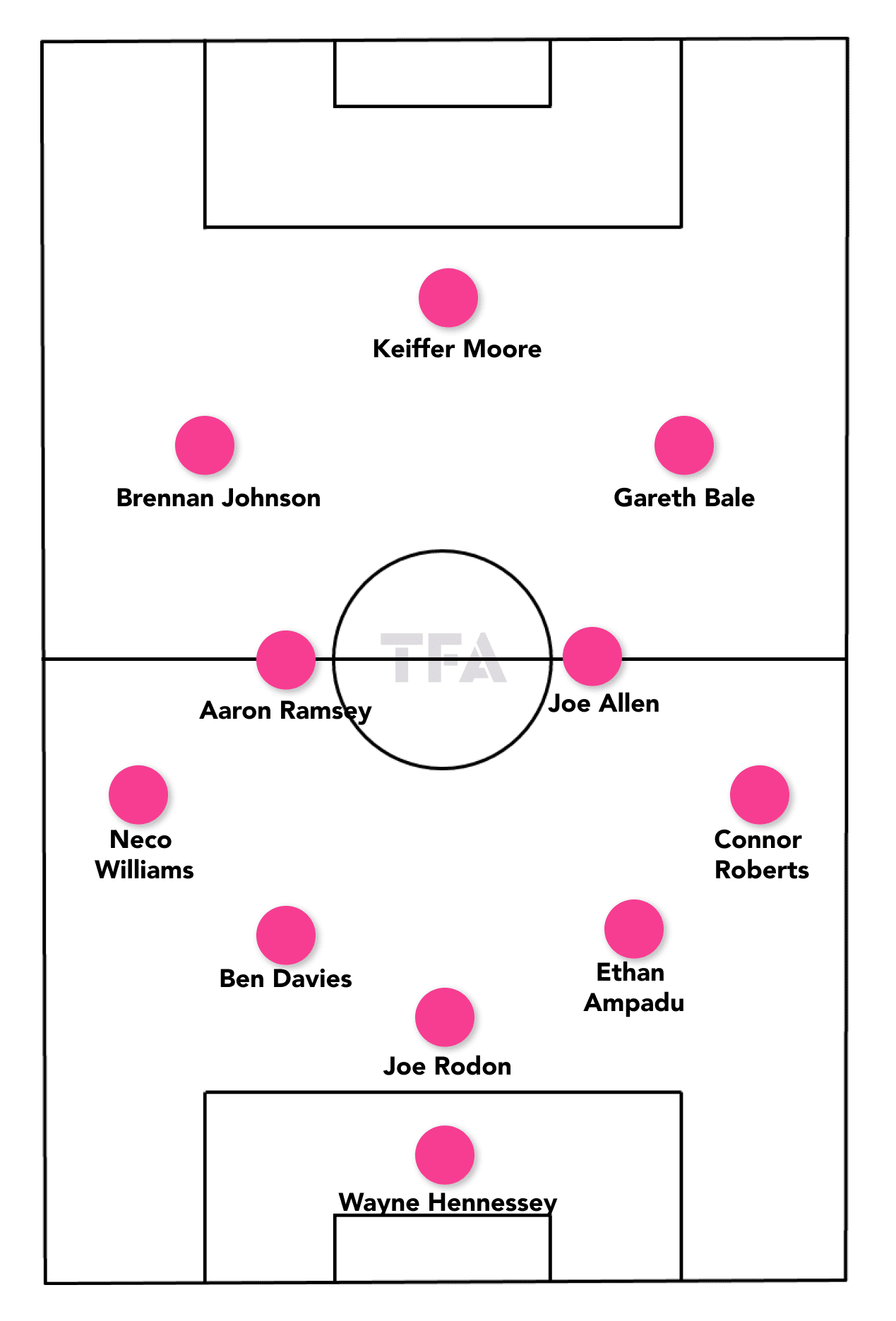
Rob Page likes to set his side up in one of two formations. 5-3-2 or 5-2-3, the latter is what I believe will be preferred in Qatar. The impact of attacking wide players such as Dan James and Brennan Johnson makes Wales dangerous going forward. The formation has been well-drilled and each player knows their role. It provides a good balance in all areas of the pitch and can be adapted if it needs to be.
Wayne Hennessey is Wales’ number 1; he currently has 106 international caps, three less than current record holder Chris Gunter. Hennessey has been reliable over a long period of time and is settled as the first choice. Other ‘keepers such as current Leicester City number 1, Danny Ward, will also be in contention for a place if anything happens to Hennessey.
The likely backline consists of some experience with a new youthful core. Players such as Neco Williams, Ethan Ampadu and Joe Rodon are all relatively young and will provide a good base on which to build for the future. Ampadu is close to 40 international caps at the age of 22 and will no doubt be a mainstay in the Wales side.
Connor Roberts and Ben Davies of Spurs will make up the defence in what is a very settled, tried and tested backline. Wales are difficult to beat and their defensive unit is a massive part of this. Ben Davies provides excellent balance as he is left-footed. 21-year-old Neco Williams plays as a right-footed left wing-back which, at times, has its limitations but mostly works well for this team. Chris Mepham can provide good cover for the central defenders and has hit some good form so far this season.
Moving on to the midfield which is an area of quality for Wales. Aaron Ramsey and Joe Allen have played numerous times together and are the heart of the team. They provide good experience and quality in the central area of the pitch. Allen now plays for Swansea City and enjoyed a positive start to the season. He has made 72 international appearances, just fewer than midfield partner Aaron Ramsey.
Ramsey has moved to Nice and has featured quite regularly for the French outfit. Both now 32 and 31 respectively means that it is likely their last international tournament. The midfield area can also be covered by Ethan Ampadu who has played for his country in midfield. His versatility means he is well able to cover if needed and he helps if Page opts for a 5-3-2.
The attacking unit of the team is an area that is really well-balanced and utilised. The likely front three will consist of top goalscorer Gareth Bale on the right, Keiffer Moore through the middle and Brennan Johnson on the left. Dan James can also be included in this conversation as he and Johnson will likely rotate based on form. The attack is really well balanced with Moore acting as a target man allowing for Johnson and Bale to play off him. Bale is dangerous from the right-hand side and his set pieces are something to look out for.
When looking at the squad age profile it is apparent that Wales have a majority of their squad in the peak-age category, represented by the pink band, though plenty of their key players fall beyond their peak. The group of players in this peak-age section and that to the left of it bodes well for the future of Wales. A good youthful squad will provide for the future with a mix of more experienced players giving good value both on and off the pitch.
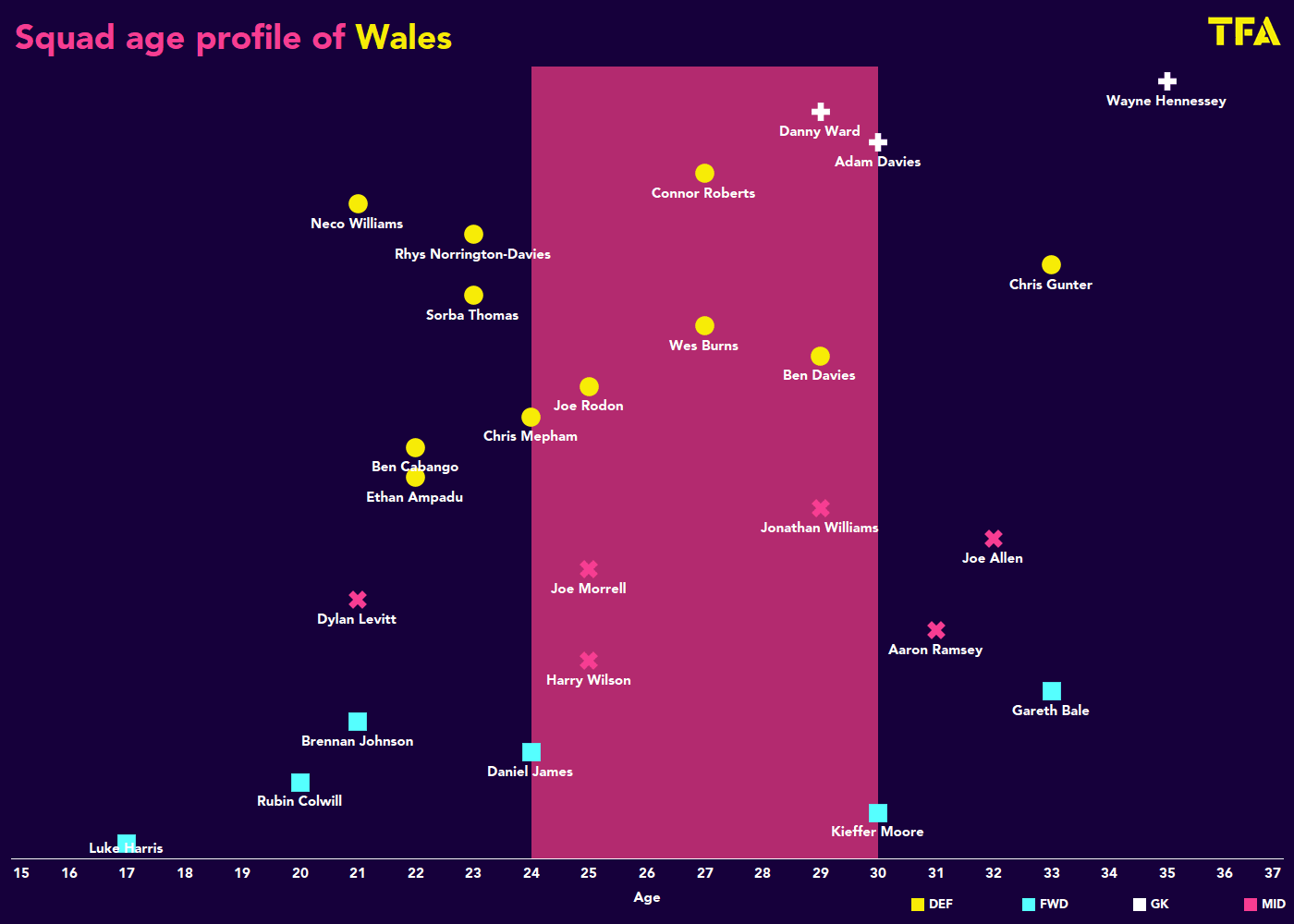
Attacking Phase
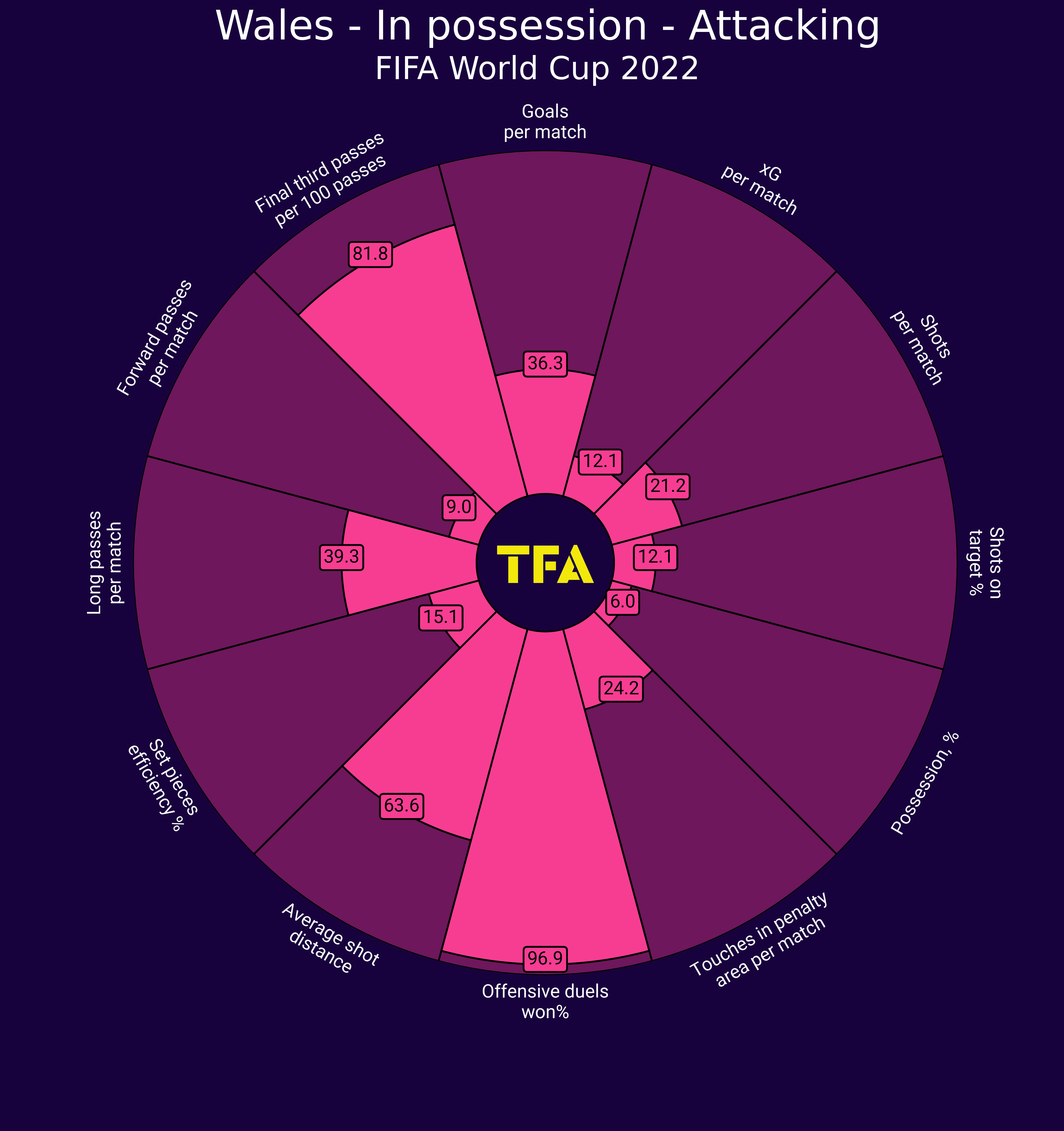
The data above shows Wales’ style of play and reflects how they like to attack. Their incredibly high rank for offensive duels won shows how successful they are in building attacks and maintaining the ball in the final third. They play to their strengths, which will be covered later, the data above paints the story for Wales.
They expect to not have a large amount of possession, hence the low rank for possession, and they also rank low for shots per match and forward passes.
Further in the article, we will discuss and cover how wales attack and how they manage to create chances. Their style is well suited to the players, and they all know their roles and responsibilities perfectly.
Wales’s attacking style is interesting. They look to play to their strengths — their wide areas. With brilliant wingers and wing-backs, Wales are very creative and dangerous from the wide channels. Not only this, they play to Keiffer Moore’s strength, which is aerial. Moore is a massive threat from balls in the air. This attribute plays well into Wales’s excellent wing play.
When trying to build an attack, Wales are capable of playing short with their defenders. Their centre-backs are all extremely comfortable on the ball; Ampadu and Davies are excellent at progressing play with accurate passes. However, Wales are comfortable in mixing their style of play up. They are great at creating opportunities for Moore to compete in aerial duels. The image below shows how they work a situation so that they can benefit from it.
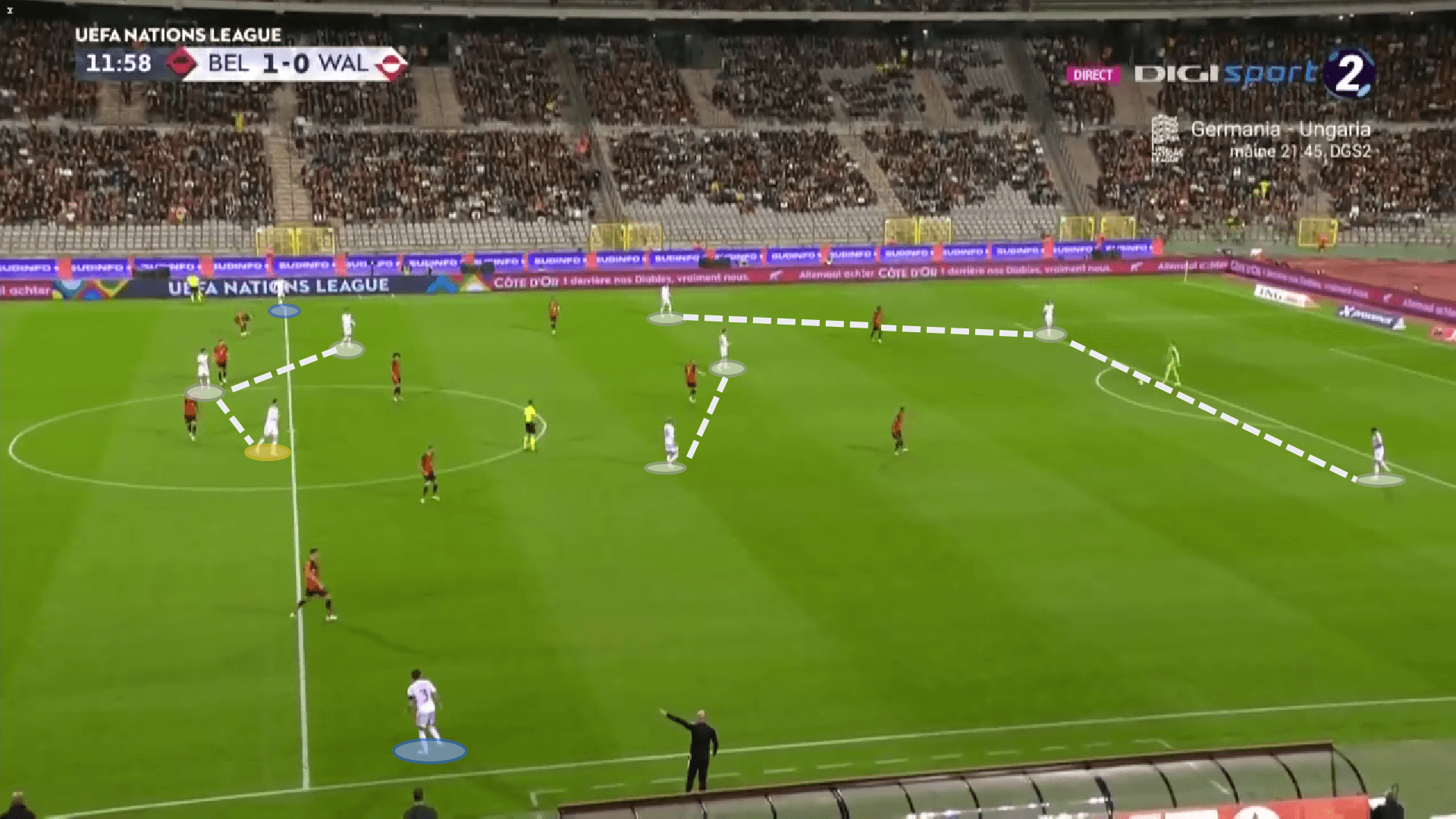
The above image displays several things. Firstly the wing-backs — highlighted blue — are as wide as they can be. This allows for the attacking players to play more centrally but more importantly, closer to Moore. The front three is relatively narrow and Moore, highlighted yellow, swaps positions with a winger when he is expecting an aerial ball.
By doing this the chances of having a duel against a weaker opponent are increased as, usually, the central defenders are the strongest in the air. Moore likes to play on the full-back where he has a better chance of winning the ball. His teammates are alert to this and position themselves well for a flick into the space behind. Below is another example of how this change happens and how effective it is.
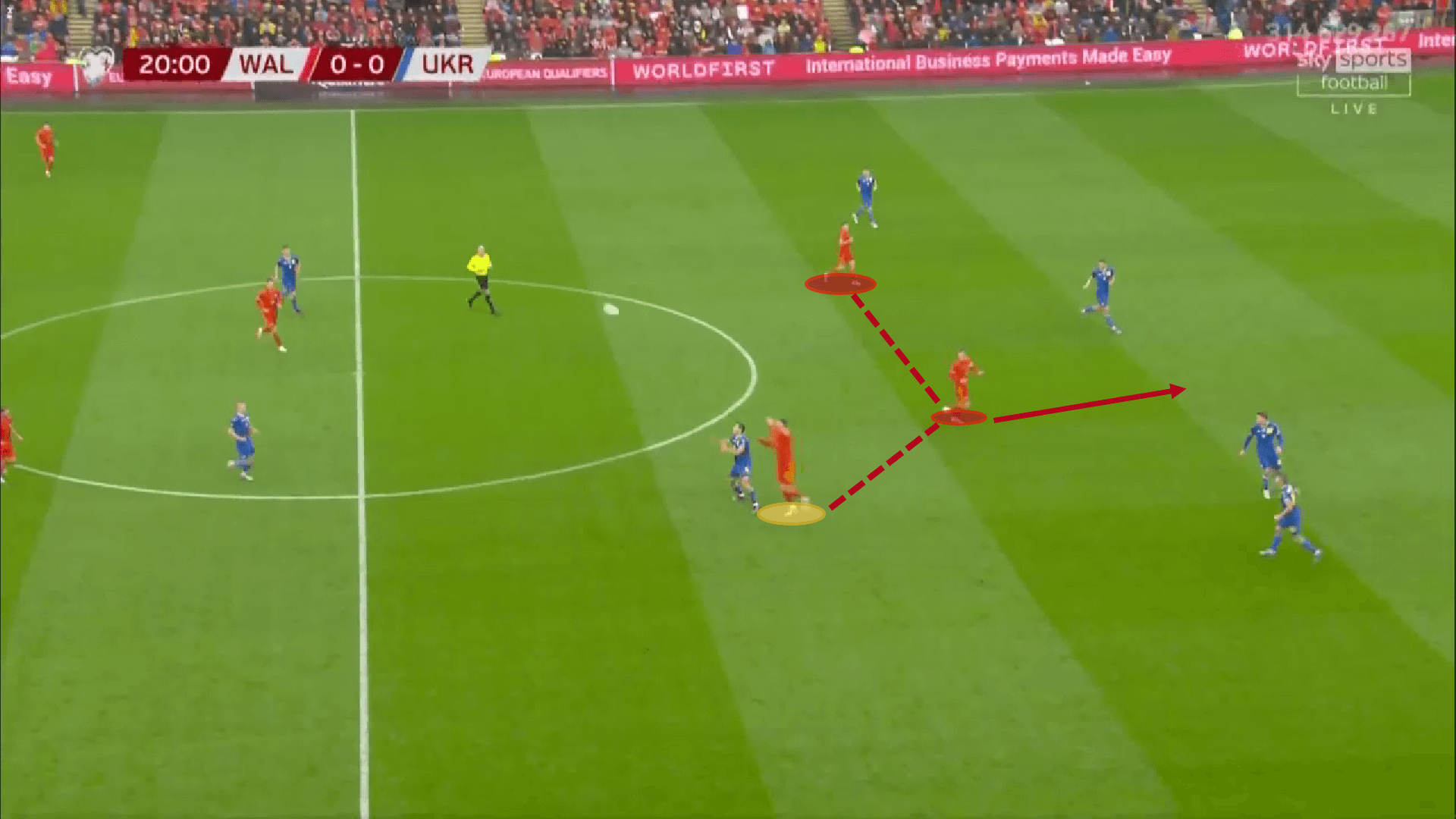
In this example, Moore drops deep to challenge a midfield player for the ball. Bale rotates with him and takes up a central position and is ready to attack the space if Moore wins the header. This clear strategy of playing forward quickly causes teams trouble as the fast movements and position changes as well as physical mismatches are difficult to combat.
As mentioned, Wales excels in their wide areas. Dan James, Brennan Johnson, Gareth Bale and Rabbi Matondo provide excellent depth and ability for Rob Page. They are all confident and direct in 1v1 situations. This helps to create goalscoring opportunities for teammates in the box. Below is an example of how Brennan Johnson creates a goal for Moore with his direct dribbling ability.
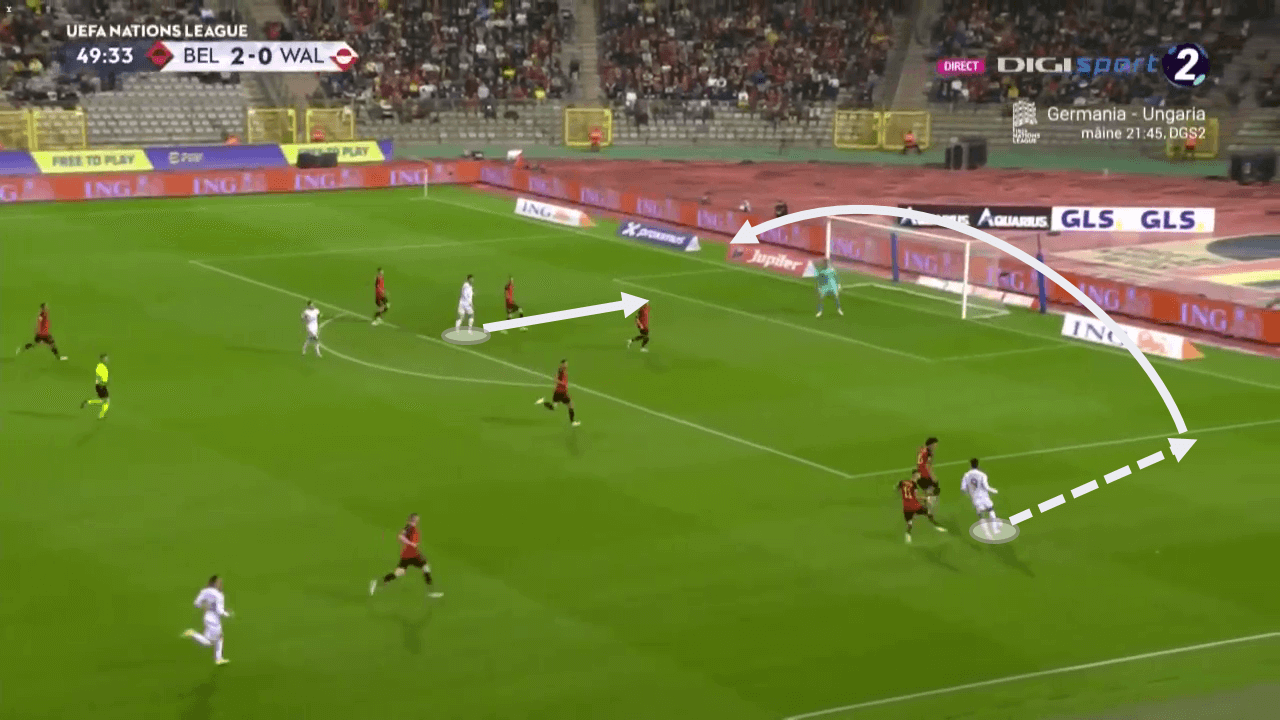
Johnson uses his dribbling ability to directly attack the space towards the byline. He is quick at changing direction and accelerating from tight areas. Johnson then sends in a lovely cross to Moore who nods it home. A Wales-style goal that couldn’t be created any better — excellent wing play finished by the target man.
Not only do their wide attacking players create excellent chances but their wing-backs provide attacking output. Neco Williams has been great for Nottingham Forest this season, playing as a wing-back. He is a very influential attacking player for Wales.
The wing-backs often find themselves as the furthest players forward and always provide width. This allows for the attacking players to play centrally and combine more quickly with each other. Furthermore, if a wing-back is crossing the ball, more players can position themselves in the attacking box. Below is an example of how Neco Williams finds himself in an advanced position with the attacking players taking up the central areas.
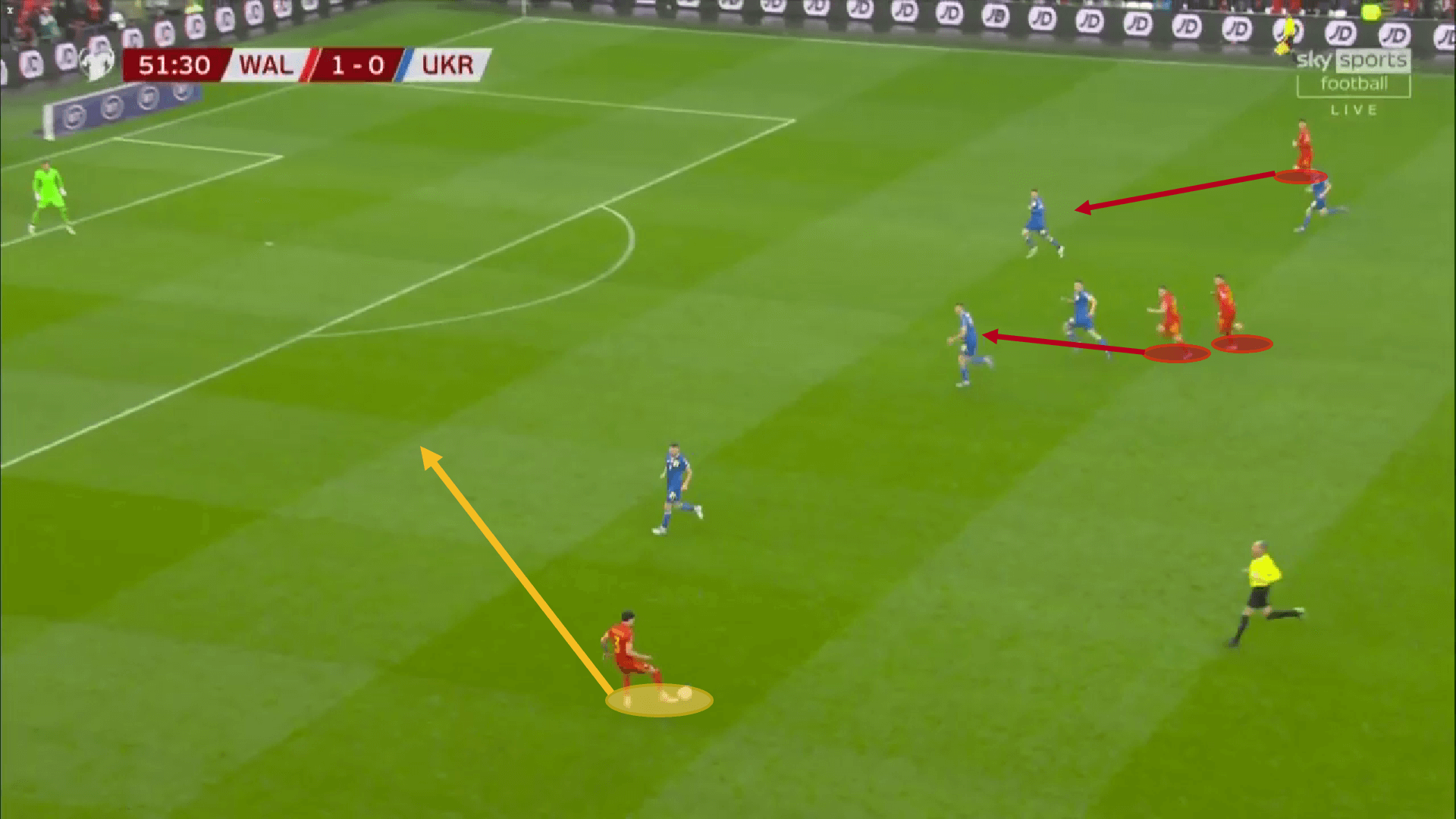
Williams attacks the space before crossing the ball into his teammates — a real attacking system that has been tailored to fit the needs and gain the best from the players involved. Wales create chances in the box and look to cause problems for the opposition.
Another method of attack to keep an eye out for is their long throw — something that Iceland had great success with during the 2016 Euros and, perhaps, can bring Wales some similar fortunes. Connor Roberts is the man who can hurl the ball into the penalty area. His throwing is dangerous and can easily lead to goalscoring opportunities. By targeting Moore, they are likely to win the first ball and the way that they set up enables them to capitalise on any loose balls. This tactic can cause drama and unrest for the opposition defenders — definitely something to watch out for.
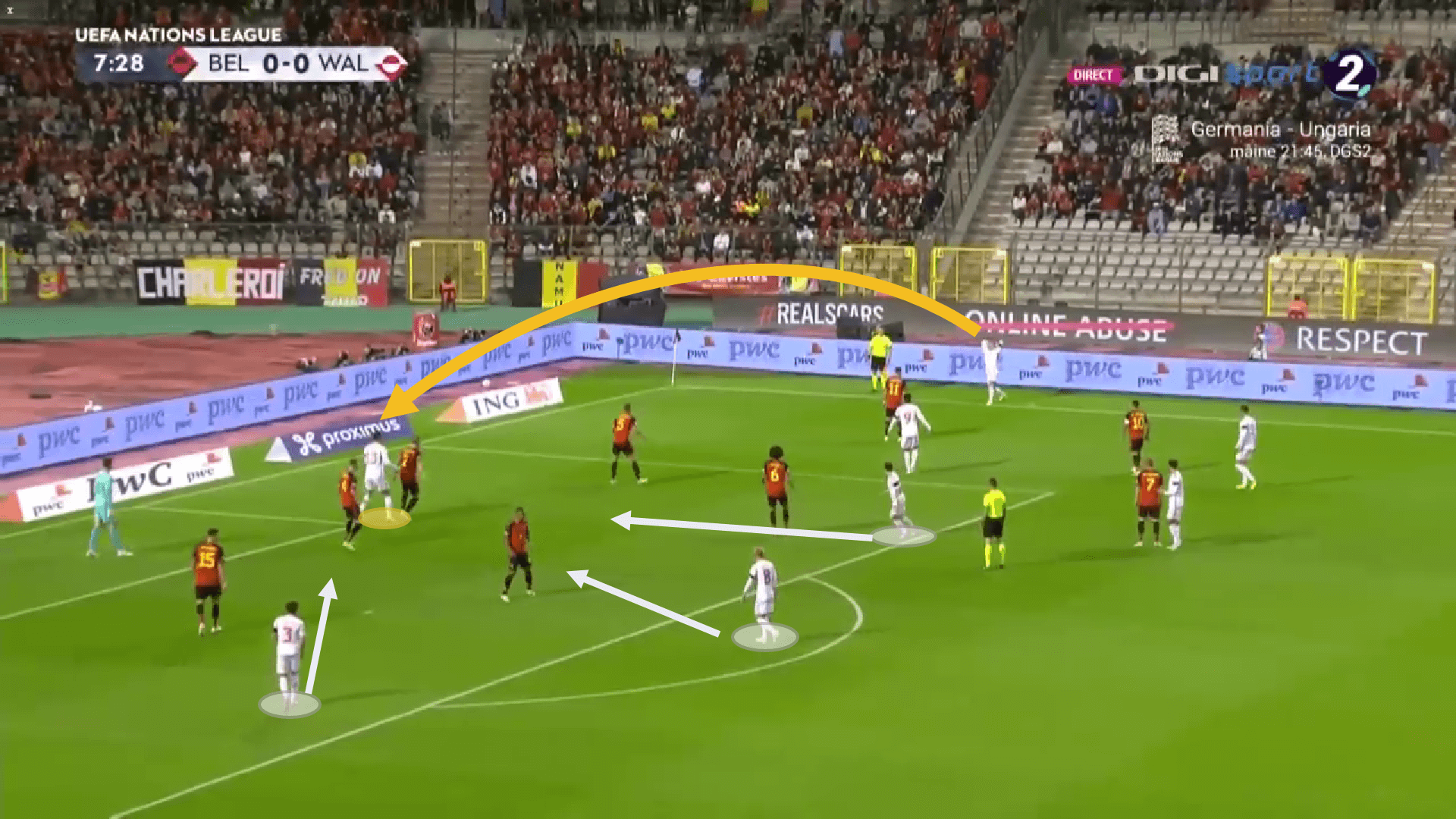
Defensive Phase
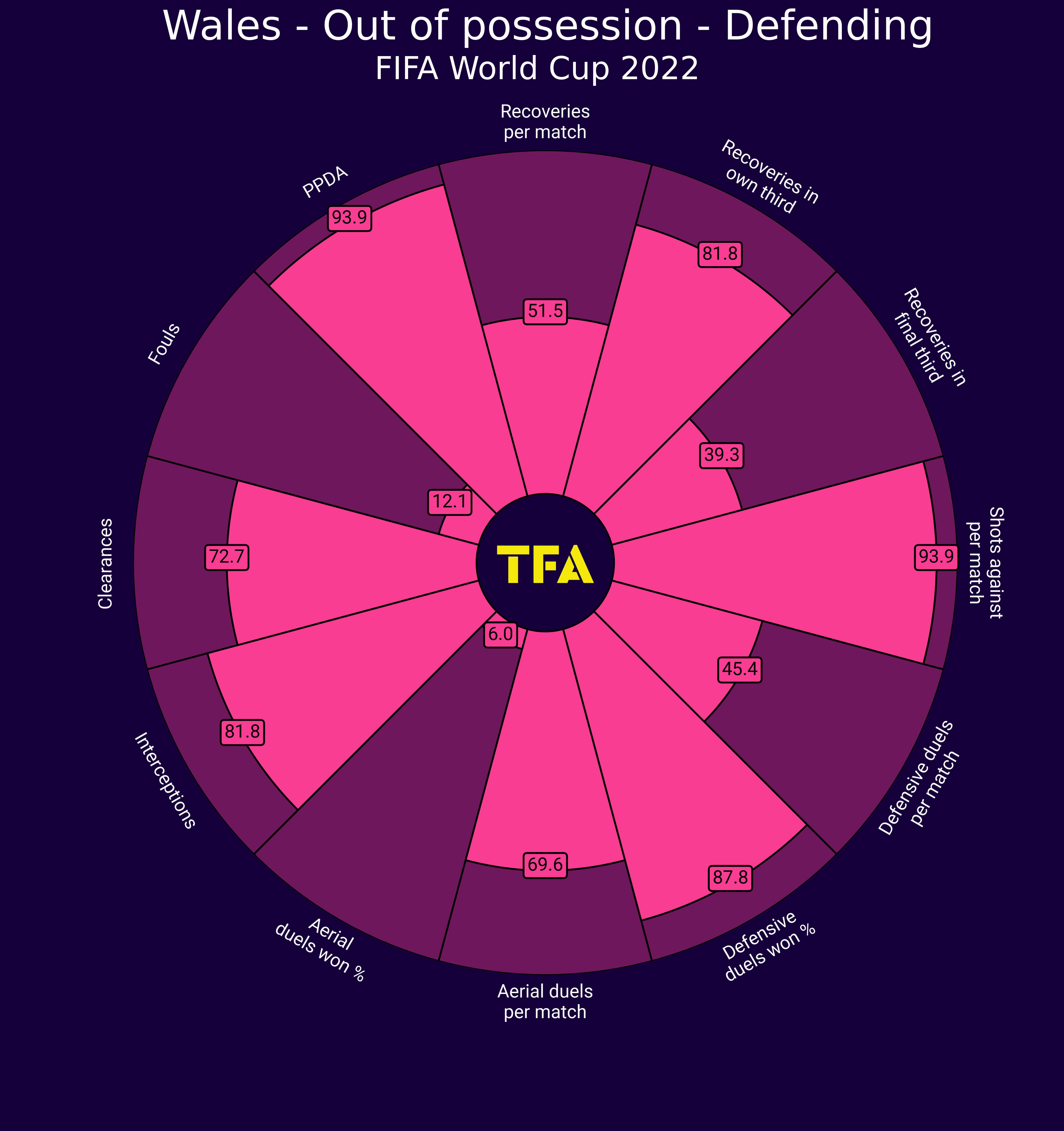
The data above shows how Wales rank in some key defensive metrics. A high rank for defensive duels won shows how physical they are as a team. Furthermore, a high percentile rank for PPDA shows that Wales do not engage aggressively in pressing their opponent high, which will be covered in more detail shortly.
Some slightly worrying data is their high rank for shots against per match, this shows that the opposition can get shots off fairly frequently. This could potentially lead to goals which need to be amended.
Another interesting area is the recoveries in the final third and own third. These two areas contrast each other massively and give a clear insight into the way that Wales look to defend. A high ranking for recoveries in their own third is because Wales are happy to sit back and be hard to break down.
When defending from the front, Wales do not press aggressively and much prefer to direct play to an area or space via their organised and disciplined shape. Below is an example of how Wales set up when the ball is high up the pitch. The midfield players of Wales, Ramsey and Allen coloured yellow, step high up the pitch and look to engage quickly if the ball is played centrally.
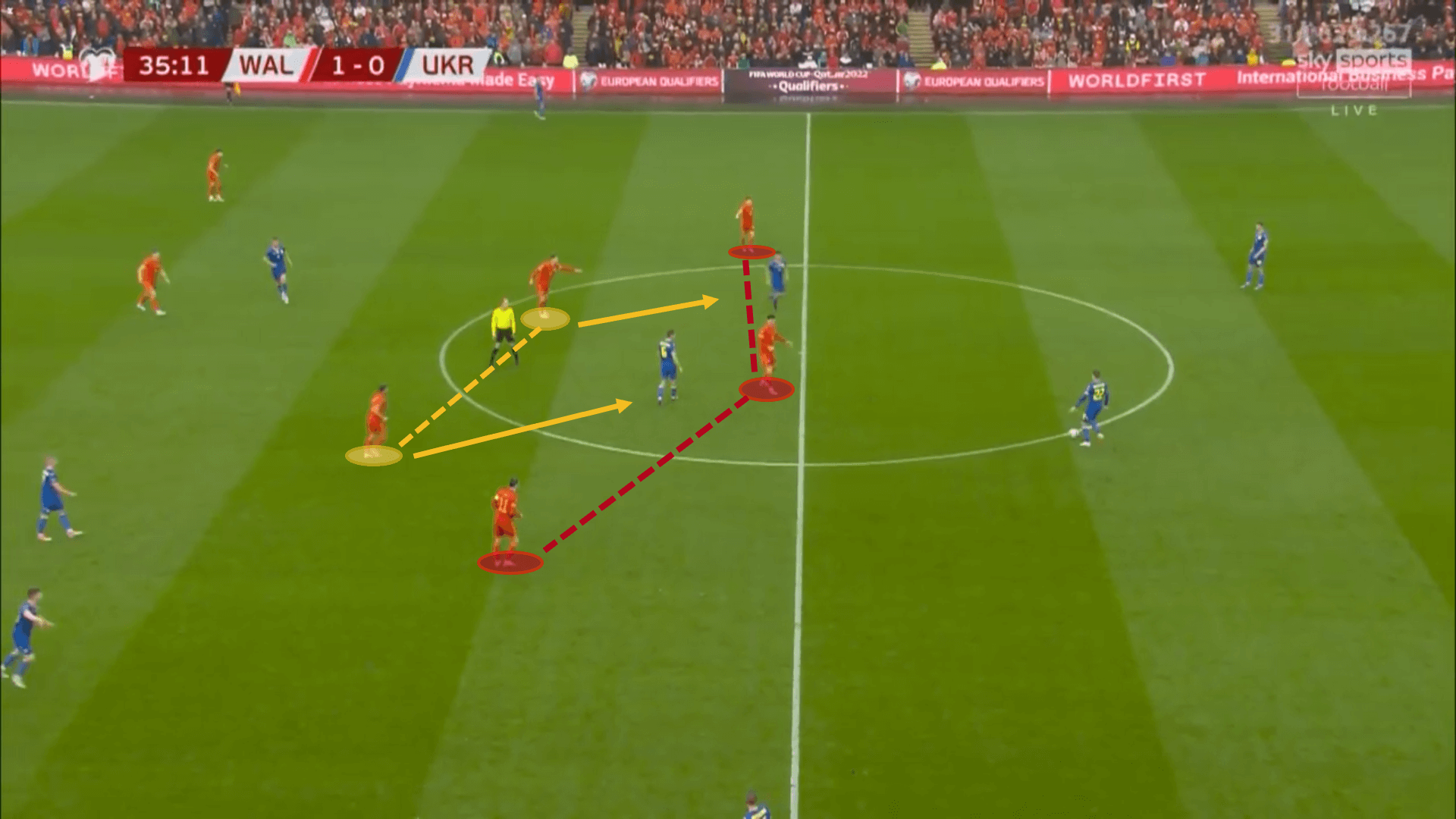
The forward players maintain a solid shape and do not look to engage any higher than they currently are. Doing this makes it hard for the opposition to play in the attacking half of the pitch. The emphasis is on the opposition to play wide. Wales heavily mark the central area and try to stop the ball from being played through the middle of the pitch.
This works well as the ball is often forced wide, and they can deal with it more comfortably in the wide areas with their wing-backs. However, if the central area is penetrated, then a really dangerous attack will take place. This is because the midfield is no longer able to cover the defensive unit and the opposition now have a free run at the defence. This is something that Wales must be wary of as it can cause them defensive issues.
Furthermore, whilst remaining in shape, Wales maintains their 5-2-3 formation which allows them to cover a wide range of the pitch. The wing-backs take the wide channels with the central area crowded by the two midfield players and three centre-backs.
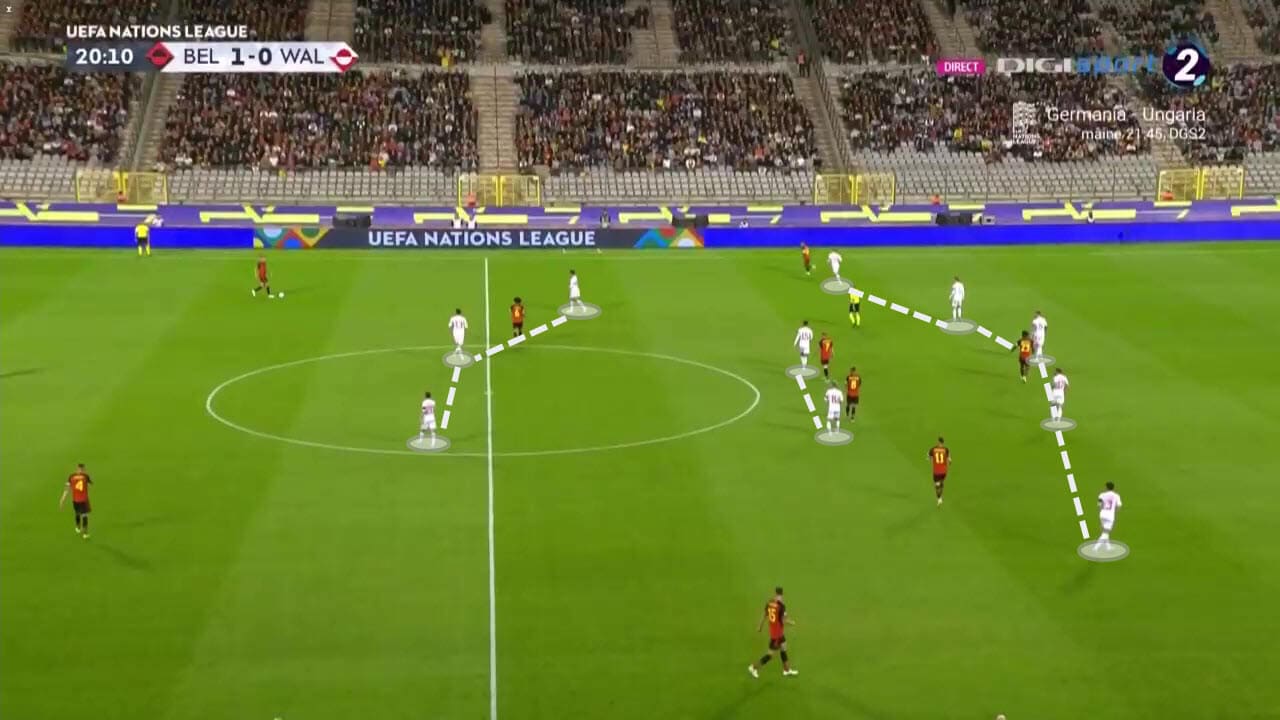
As mentioned above, Wales do not look to press high up the pitch. Their main objective is to stop the ball centrally. There is a large emphasis on the central midfield players to make sure that they get their distances right. They need to be close enough to the defensive unit so they can screen it but also not too close so that there is space in front of them. Their role is difficult and they must remain disciplined in their role.
The defensive unit have to ensure that their line is at the perfect height on the pitch. They must be a good distance away from the goal and high enough to make the pitch smaller for their opponents. The defensive unit is relatively mobile and quite good at recovering.
Along with this, the forward players have to work hard to cut the opposition’s passing lanes off. If they do this, then it is increasingly difficult for opponents to play through into the midfield. Not only do they need to make it difficult they must be aware of the current situation in terms of regaining their shape and dropping in deeper.
Leading on from this, the defensive shape that Wales take up when they are defending deeper ensures that they can frustrate opponents. Their style out of possession is well-drilled and they are rarely played through centrally. The below example shows how they defend the penalty area.
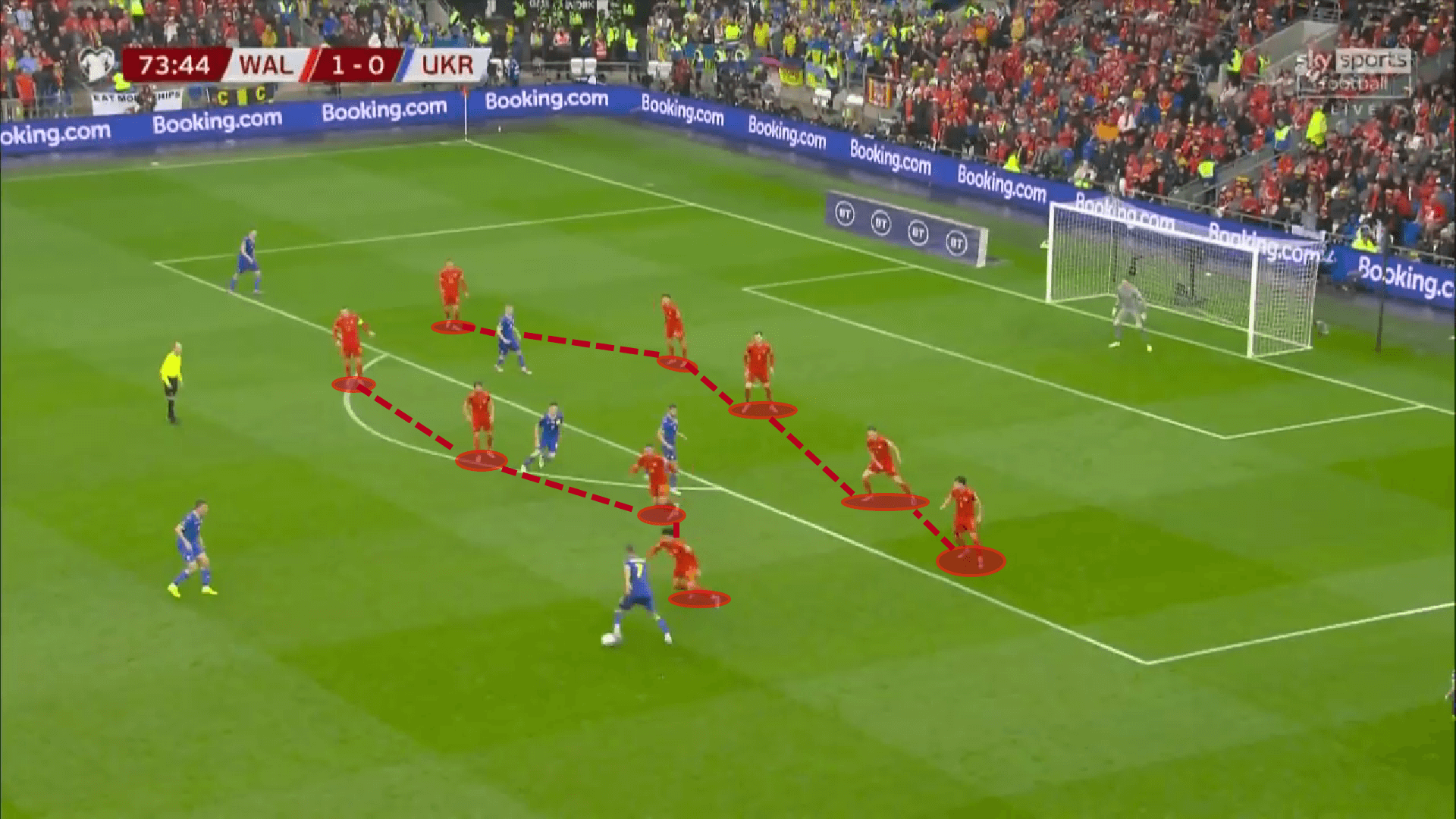
The wide attacking players drop deep to create a bank of four alongside the central midfield players. The distances between the left and right of both the midfield and defence is very narrow. This again emphasises the importance that Wales have placed on defending the central areas. The midfield unit must choose when to engage with their opponents. A heavy touch is a perfect trigger to try and regain possession or disrupt play.
Transitions
Wales look to play forward quickly and be direct in offensive transitions. They don’t break forward with a lot of support other than the wide players. Most of the attacking transitions go through Moore; he is usually the recipient of a long ball to his chest or into space he can run into.
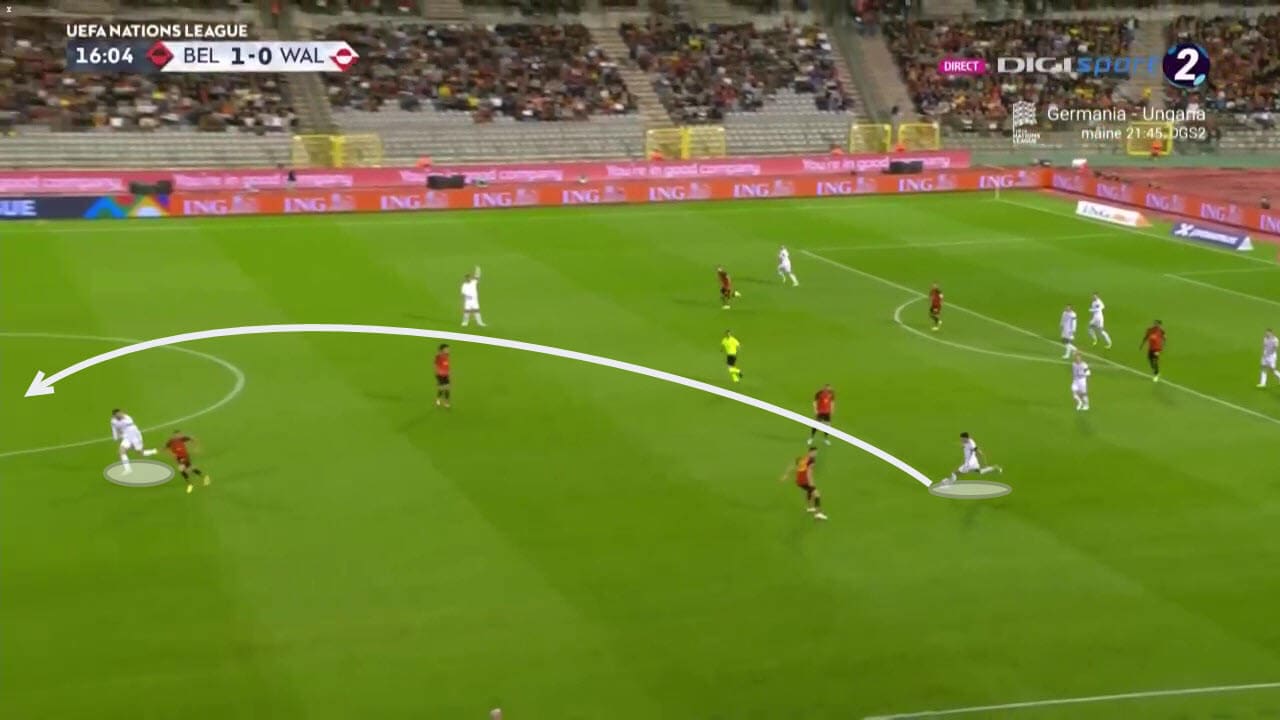
Once the ball has been played, Moore looks to hold possession and wait for support from his teammates. This usually comes from the wingers, and they can look to build an attack from there.
Defensively, Wales transition quickly into their defensive roles. They are quite conservative in the way they move and do not look to over-commit themselves to any challenges that could leave them exposed. As previously mentioned, Wales are not a high-pressing side. Pictured is an example of how Wales monitor the situation by the nearest player engaging.
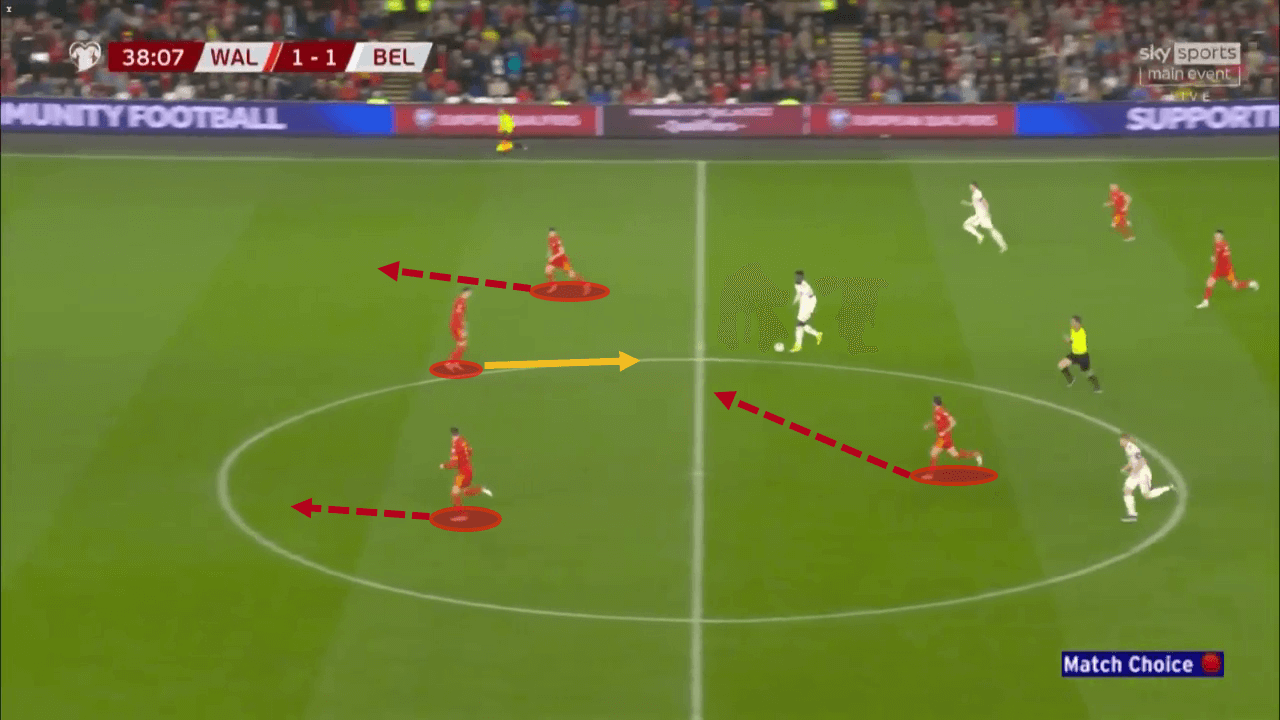
The defender with the yellow arrow looks to delay the opponent by cautiously engaging him. This, hopefully, slows down the opposition’s attack whilst another Welsh player looks to come in and tackle.
Attackers
Wales’ attacking options are quite plentiful, especially in wide areas. As mentioned previously they are blessed with the likes of Bale, James, Johnson and Matondo. The majority of these wide players are comfortable playing across the front three as a striker or winger on either side. The use of Gareth Bale as a striker has been done before and is something that Page could look to do, depending on the game.
Speaking of the striker position, Wales are relatively lightweight in terms of numbers. Keiffer Moore is such an influential player for the style of play they implement that if something were to happen, like an injury or suspension, Wales would be likely to play Bale centrally. An area that provides so much success for Wales must be monitored by Rob Page throughout the tournament.
Midfielders
The middle of the pitch has an abundance of young talent along with a wealth of experience. If fit, Ramsey and Allen are first-choice midfield options for Wales, however, both have been known for picking up injuries and this must be accounted for. Players such as Harry Wilson and Joe Morrell could easily feature in the midfield and are perfect rotation options for Ramsey.
Furthermore, the likes of Ethan Ampadu can play in the midfield which brings good versatility and options for Page. Along with Ampadu midfielders such as Jonny Williams, Dylan Levitt and Rubin Colwill could also feature depending on minutes, fitness and scenarios.
Defenders
The defensive unit almost picks itself. The mainstay players such as Wayne Hennessey, Ben Davies, Ethan Ampadu, Joe Rodon and Connor Roberts will be accompanied by the young and exciting Neco Williams. Chris Mepham and Ben Cabango provide excellent cover for the central defenders with Sobra Thomas, another exciting full-back, giving depth in the wider areas.
Key Player
Of course, Gareth Bale is the main man in the Wales squad but since moving to the MLS, his minutes have been limited and his form hasn’t been great. Neco Williams, on the other hand, has been making an impact in the Premier League for Nottingham Forest of late.
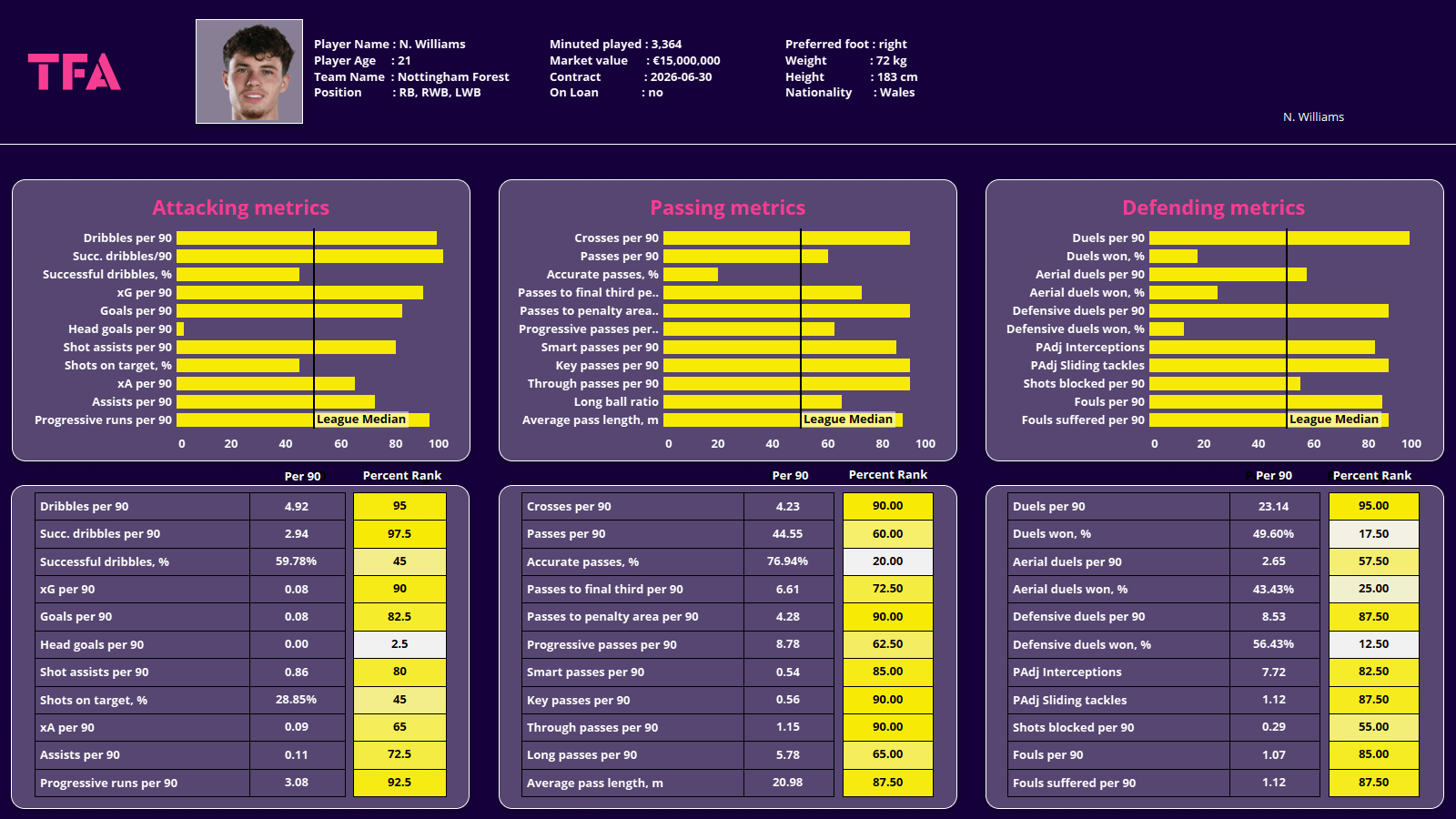
The young wing-back joined from Liverpool in the summer and has started brightly in the Premier League. His overall game is vital and provides a good balance to the Wales side. At wing-back, he covers a large area of the pitch whilst having a lasting and continuous impact on the game.
Attacking-wise, his data is really impressive, though he’s got relatively little experience in the Premier League. His percentile rank of 97.5 for successful dribbles per 90 shows just how direct he is on the ball. To continue, his progressive runs per 90 percentile rank, 92.5, again tells us how direct and forward he is. On top of all this is a danger in front of goal ranking in the 90th percentile for xG per 90 and 65th percentile for xA per 90.
Moving on to his passing, his passing data again shows his quality and ability on the ball. A high rank for crosses per 90 could come in useful due to Wales’ style of play. Furthermore, his creative ability is backed up even more by his high ranking for both smart passes per 90 and key passes per 90. Both areas show how progressive on the ball Williams is, something that can hopefully lead to success in the tournament.
Finally, his defending data, which again possesses some real quality. His PAdj interceptions and sliding tackles both have him higher than the 80th percentile, giving Rob Page confidence in the young defender. However, there are a few areas of concern, such as duels won % and defensive duels won %. Both of these metrics rank Williams in the bottom 20th percentile. An area of weakness that could perhaps be targeted by the opposition. Having said this, playing as a wing-back does tend to reduce defensive responsibility so Williams should be able to manage as a nearby centre-back or midfielder will be able to offer a helping hand.
Tournament Prediction
Wales find themselves in a difficult group competing with England, Iran and the USA. A win in their first game against the US would put down a huge marker for the rest of the group. Their second game is a must-win if they are looking to qualify out of the group stages, while their tasty affair with England in the final Group Stage match could be set up for an all-or-nothing scenario depending on the results — Wales will fancy their chances against anyone.
Their group togetherness accompanied by their national spirit has seen Wales cause upsets before. I wouldn’t be surprised to see Wales comfortably qualify out of the group stage with a few ‘surprise’ results.

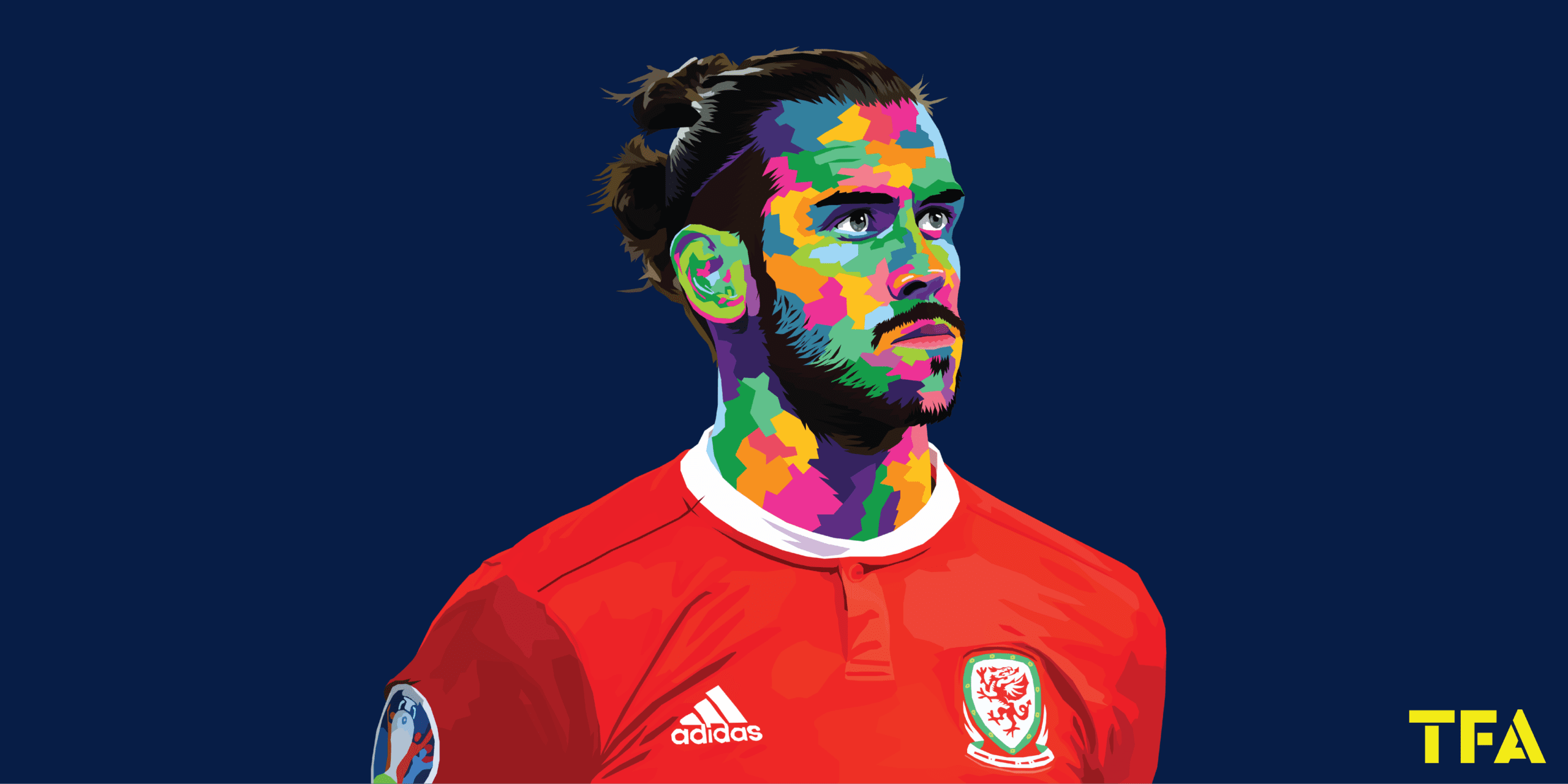



Comments